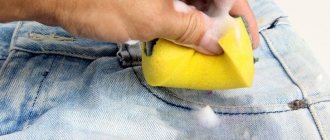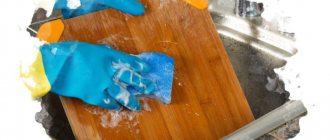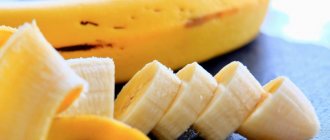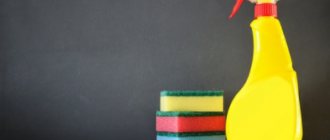Fresh beet juice is corrosive and, if removed incorrectly, can leave behind a light stain or not come off at all. Countless amounts of beloved clothing have been ruined by the juice of this undoubtedly healthiest vegetable. But don’t rush to get rid of things that you have stained with beet juice; there are methods on how to wash beets and at the same time, without damaging the fabric, return it to its original purity.
Of course, the method of getting rid of marks largely depends on the item that was stained. Depending on the color and texture of the fabric, the effectiveness of different methods differs. So, for example, we will wash jeans and a shirt made of white fabric differently.
How to remove a beet stain
There are several general tips for housewives on how to remove beets from clothes:
- To wash beets quickly and painlessly for things, you need to act immediately. The soiled item should be placed under the hottest, running water and kept there. Water will prevent the juice from being absorbed into the fabric.
- Add a little stain remover and wash the item. It is better to do this in a washing machine rather than by hand. Thanks to this, you can wash off borscht and other traces of beetroot juice with the least effort.
- In situations where washing is not possible, it is necessary to sprinkle the damaged area with regular table salt. This will not get rid of the stain, but it will help absorb excess juice, which will help with subsequent washing. Sprinkle generously; do not skimp on salt.
Of course, you should check whether the structure of the fabric allows such handling. Don't ruin the thing. If the fabric does not tolerate high temperatures, then you should use one of the tips described below. The main thing is, don’t let a stain from borscht or juice ruin your mood; thanks to us, you can easily wash them off.
Basic cleaning rules
If you use the same methods to clean stains from a red cotton shirt and a white polyester T-shirt, you may not only waste time, but also lose your favorite item.
Washing rules:
- Synthetics should not be washed with hot water unless the manufacturer instructs to do so.
- Difficult stains need to be cleaned in several stages.
- Linen items need to be washed more thoroughly than synthetics. This process will require more effort.
- Don't put off until later what you can do now.
We remove old stains
Despite the effectiveness of available products, the most convenient way to remove beet stains from clothes is with the help of special powders and stain removers.
In cases where the stain is old, it is better to pre-wash and soak the item for a while in water with the addition of special cleaning agents.
As an alternative, you can use powders for washing children's clothes. Their composition allows you to best get rid of any dirt, but there is a risk of slightly lightening the washed clothes.
In addition to special products, you can use a mixture of glycerin and egg yolk. This method of removing stains has proven itself well. It is necessary to mix glycerin with egg yolk in a one to one ratio and apply to the stain, let stand for 10-15 minutes, then rinse with water. To enhance the effectiveness of this method, you can dissolve one spoon of citric acid or hydrogen peroxide in the resulting mixture.
It is possible to remove contaminants using glycerin and citric acid. The mixture must be dissolved one to one and rubbed into beetroot marks before washing.
| How to wash it | Time required | How to use | Equipment |
| Wash in running water | up to 5 minutes | Immediately after the stain has formed | Warm water |
| Machine washable with stain remover | About 1 hour | Suitable for both new and old stains | Automatic washing machine, stain remover |
| Sprinkle salt on the stain (prevention) | up to 10 minutes | Immediately after the stain has formed | Salt |
| Cleaning products containing acid | up to 15 minutes | Within an hour of stain formation | A mixture of water and vinegar, citric acid, cleaning products |
| Milk and dairy products | about 30-40 minutes | Within an hour of stain formation | Milk |
| Heated ethyl alcohol | 20-30 minutes | Suitable for both new and old stains | Heated ethyl alcohol |
| Washing and soaking using special products | 3 hours or more | Suitable for both new and old stains | Special cleaning products |
| Powders for washing children's clothes | about 1 hour | Suitable for both new and old stains | Automatic washing machine, stain remover |
| A mixture of glycerin and egg white | 15 minutes | Suitable for both new and old stains | Glycerin, chicken egg, water |
| Ammonia and ammonia | 10 minutes + wash | Suitable for both new and old stains | Ammonia, ammonia, sponge, rag |
| Soaking in bleach | 3 hours or more | Suitable for both new and old stains | Bleach, water |
| Dishwashing liquid | up to 5 minutes | Immediately after the stain has formed | Dishwashing liquid, water |
| Boiling | an hour or more | Suitable for both new and old stains | Constantly boiling water |
| Grouting with the back of the sponge | up to 15 minutes | Only for old stains | Hard sponge, water |
| Washing with laundry soap | from 5 minutes or more | Suitable for both new and old stains | Laundry soap, water |
Cotton and linen
How to remove beet stains from cotton and linen clothes? It is recommended to wash linen items in hot water and soda. You can remove old beet stains with both hydrogen peroxide and a 5% ammonia solution. You can remove stains with sodium hydrogen sulfate and peroxide. First, the mark is sprinkled with sodium bisulfate, then hydrogen peroxide is dripped in, and then washed off with cool water. If you acidify it with vinegar or citric acid, the effect will be better.
How to clean beet stains from colored items
To remove traces of beets from jeans or dresses, use dishwashing detergent; make sure it does not contain strong chemical components.
Washing with laundry soap will not damage the fabric and will allow your suit to remain as colorful as before. When using soap, to improve the result, soak the washed area in water for a while.
It is best to use special products for colored suits that will remove stains as safely as possible for the fabric.
Cushioned furniture
Ammonia dissolved in water will help wash both the shirt and the sofa. For 125 ml of water you will need 1 tbsp. l. ammonia. The sofa upholstery is first blotted with a paper napkin or bread crumb so that the stain does not spread. Then soak in the cleaning solution and leave for a couple of minutes. There is no need to rinse off the composition. It is simply blotted with a dry soft cloth or napkins. If necessary, repeat the procedure.
If it was not possible to completely remove the beet stain, alternatively use a foamed carpet cleaner or car chemicals for cleaning the interior. The product is first tested on an inconspicuous area of the upholstery.
Dear readers of the Tkan.Club website, if you still have questions on this topic, we will be happy to answer them. Leave your reviews, comments, share stories if you have dealt with red beet stains! Your life experience may be useful to other readers.
Special chemicals
The most reasonable option for removing beet stains from clothes are powders and stain removers specially made for this purpose.
You should take a responsible approach to choosing such a product; you should definitely take into account the type of fabric you will use it to clean. It is also worth paying attention to the color of the fabric. Cleaning products for colored clothes may not be able to remove beet stains from white clothes, and products for white clothes can easily ruin colored clothes.
As a rule, all the necessary information can be found on the label. In the absence of such information, you should not take risks and it is better to give preference to a similar product with detailed instructions.
Substances containing acids are good because they are better at removing stains. In addition to household chemicals, try using sodium bisulfate. Outwardly, it resembles transparent crystals that must be dissolved in water to form a concentrated mixture.
How to wash diesel fuel using household chemicals
In most cases, home dry cleaning is carried out using special products. Many of them are very aggressive, so before use it is recommended to test on inconspicuous areas of clothing.
Dish detergent
A common product designed to remove fat deposits on dishes will also help wash diesel fuel. To do this, you just need to lubricate the stain with it, pour hot water into a basin (as much as the type of fabric allows), add a little product to it and soak the stained item there.
Stain removers
Numerous store-bought stain removers can also be used to remove diesel from clothing. The only point to consider is that this method will have to be repeated several times.
Attention! If you need to wash a jacket from diesel fuel, which cannot be immersed in a washing machine, then this method is considered the only possible, since many stain removers cannot simply be removed with a damp cloth.
Glass cleaner
Many glass cleaners contain ammonia. In combination with additional detergents, this component copes well with greasy marks. If you need to remove diesel fuel from clothes, a glass cleaner can come to the rescue. It will be enough to moisten the dirt generously and wipe the liquid with a clean cloth. After this, the product is washed with powder, and if necessary, repeat the procedure after the item has dried.
Popular folk remedies for beet juice
When removing beetroot stains, one should not lose sight of folk remedies that help in removing stains using improvised means.:
- Boiling . Keeping a dirty item in boiling water for a long time will help get rid of stains, including removing stains from beets. Unfortunately, this method is not suitable for all types of fabric.
- Soaking and washing . It will be much easier to get rid of a beetroot stain if you first wash the contaminated area and leave it under hot water for a while.
Using the back of a kitchen sponge will help you clean beet stains at home. Rub the stain thoroughly with the back of the sponge. This method can help to remove only old stains on things made of synthetic fabric.
Laundry soap
Cheap methods that help clean fabric from beet are considered to be laundry soap and machine washing. Wipe the area with traces of beets with soap, after moistening with water. Then run the machine in the appropriate washing mode for the type of soiled item. This will probably be needed to remove beetroot stains.
Vinegar and citric acid
Using citric acid and vinegar, you can remove stubborn stains from any clothing. Traces of juice can be quickly removed with these products without damaging the fabric. Proven products help get rid of bright stains.
Salt and milk
Such products also effectively remove stains from white and colored clothes. You can easily and quickly remove traces of spilled juice and borscht. Salt effectively removes bright stains from white clothes.
Remove diesel smell
Even after the stain has been removed and no traces remain, an unpleasant odor can remind you of it, which remains on the fabric for a very long time and is felt not only by the person wearing the clothes, but by everyone around. You can get rid of it in several ways, it is not at all difficult, and many of the ingredients that are needed to remove the stench can be found in almost everyone’s home. More details:
- After you have used the methods to remove stains from the item, washed it in a washing machine with powder and dried it, soak it in kerosene. It will take away the smell of diesel fuel, but your clothes will not smell like flowers. To fix this, put it back in the machine and add a couple of caps of conditioner with a pleasant aroma to the powder. This should help.
- Another way is to rub the smelly area with mint toothpaste, applying it in a thick layer, and wash it in the washing machine in the morning. After this, hang the product on a balcony or street and ventilate for several days. The smell will completely disappear, and the item will be like new.
- Oddly enough, you can remove the smell of diesel fuel using another fuel - gasoline, you just need to take the extraction version. It is used to create refined sunflower oil; it is odorless and colorless. The smelling item should be soaked for forty minutes in this liquid, and then washed, rinsed and aired several times. You can use aviation kerosene in the same way.
- If you don’t have a canister of kerosene or gasoline at home, you can also use a high-quality dishwashing detergent: dissolve about four spoons in seven liters of water, stir everything well and put the product there. Forget about it for twelve hours, and then wring everything out and wash it with the addition of aromatic conditioner. Air dry.
If a leather jacket or other similar item is stained and it is not advisable to wash it in a machine, use solvent or gasoline, then wipe the stain with lemon juice and air it for a long time in the cold or at least just in the wind - this should help combat the unpleasant odor.
Video.
As you can see, removing traces of diesel fuel is not as difficult as defeating the stench. It is best to begin the fight against pollution immediately after it occurs, but even an old stain can be removed if you try hard. It is better to use several methods in turn if the situation is difficult
The main thing is not to overdo it and not spoil the material itself, so it is important to observe the soaking time in aggressive agents
What not to do
The Internet is full of all kinds of advice on using bleach to remove vegetable oils from clothes. This is true, only partly. Its function does not include the dissolution or decomposition of fat. The oxygen or chlorine contained in bleaches is designed to oxidize certain substances and convert them into a soluble or colorless state. Fat is not one of these substances. Vegetable oil, on the contrary, when oxidized with oxygen, acquires the property of hardening after drying. As a result, instead of an easily removed oil stain, you can end up with a persistent stain that will remain until the end of the product’s service life.
The same applies to removing oil using hot water. In many cases, this method will cause the oil to spread over a large area and become simply a little lighter than it was to begin with.
Be careful when using plumbing cleaners. In most cases, they contain caustic, which can effectively decompose fat, but some fabrics can also easily become unusable
If there is no other way out, then you should first test the effect of the product on a small piece that will be invisible and the loss of which will not lead to irreparable consequences.
Bottom line
As you can see, there are quite a few ways to remove beet stains from clothes. All you have to do is choose the one that is most suitable for you and put it into practice.
Beets are a very healthy and tasty vegetable. Its juice gives a beautiful color to borscht and salads. The pigments contained in the root vegetable are called anthocyanins. They are used in the food industry as a natural dye. This indicates the stability of beet dyes. That's why it's so hard. If your favorite item gets splashed with vegetables, don’t despair. Here are several ways to remove beets from clothes.
General recommendations
Before you wash a borscht stain, pay attention to some tips:
- Begin treating the stained fabric immediately. As the beet juice soaks into the fabric and penetrates its fibers, it will become more difficult for you to clean your clothes.
- Immediately after you notice a beetroot stain on your clothing, remove it and place it under running hot water. The high temperature will stop further penetration of the pigment, and it will be easier for you to wash the fabric.
- If you can’t wash the item now, sprinkle the stain generously with salt. It will absorb excess juice, making it easier to wash the fabric.
- When using stain removers or folk recipes to remove traces of beets, be sure to take into account the composition of the fabric and the recommendations for its care indicated on the label of the item. This will help avoid deformation of the material.
However, there are still ways that will help you remove not only fresh, but also old, ingrained traces of careless use of the vegetable.











